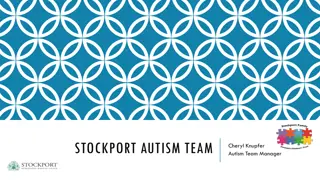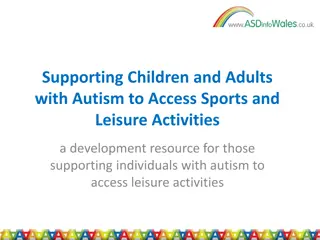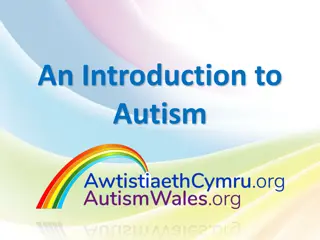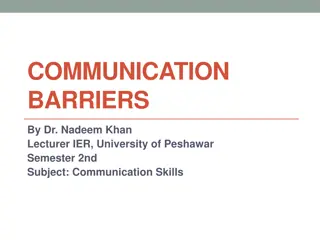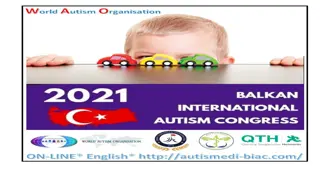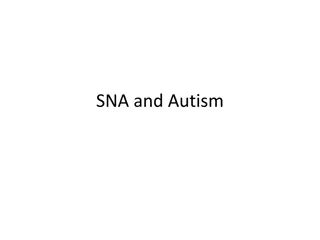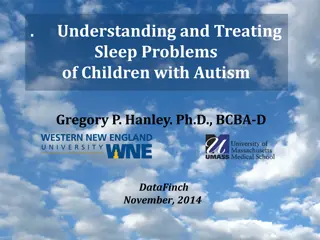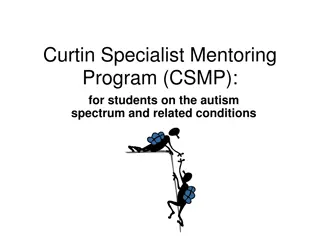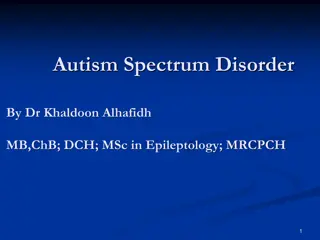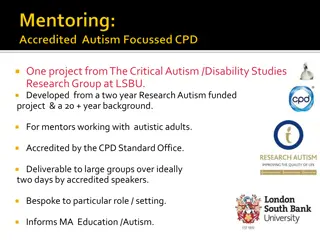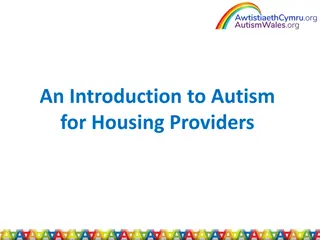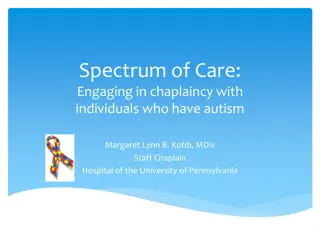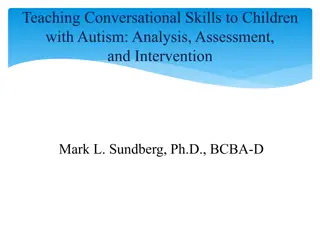Understanding and Addressing Learning and Language Barriers in Children with Autism
Children with autism face various obstacles in language and social development. The VB-MAPP Barriers Assessment helps identify and score different barriers affecting individual children. Intervention strategies should directly target the sources of control for observed behaviors. Assessment and individualized analysis are crucial in determining appropriate intervention programs. Barriers include negative behaviors, deficits in verbal skills, impaired social behavior, and physical/biological limitations.
Download Presentation

Please find below an Image/Link to download the presentation.
The content on the website is provided AS IS for your information and personal use only. It may not be sold, licensed, or shared on other websites without obtaining consent from the author. Download presentation by click this link. If you encounter any issues during the download, it is possible that the publisher has removed the file from their server.
E N D
Presentation Transcript
Overcoming Barriers that Impede Language and Social Development in Children with Autism Mark L. Sundberg, Ph.D., BCBA-D (www.marksundberg.com)
Learning and Language Barriers Children with autism face many obstacles Behavior analysis has much to offer, more than just procedures The importance of assessment/analysis It is important to find out what a child can do, but it is also important to know what he can t do, and analyze why he can t do it The VB-MAPP Barriers Assessment is a tool that is designed to identify and score 24 different learning and language acquisition barriers that may be affecting an individual child What is the source of control for the observed behavior (ABC) Intervention must directly address the relevant sources of control Many sources are less obvious or researched than others
The VB-MAPP Barriers Assessment Once a specific barrier has been identified, a more detailed descriptive and/or functional analysis of that problem is required There are many ways that a verbal repertoire or related skill can become defective or impaired, and an individualized analysis will be necessary to determine what the nature of the problem is for a specific child, and what intervention program might be appropriate
The VB-MAPP Barriers Assessment There are several different types of barriers that can affect learning and language development Strong and persistent negative behaviors that impede teaching and learning (e.g., non-compliance, tantrums, aggression, SIB) Verbal operants or related skills that are absent, weak, or in some way impaired (e.g., echolalia, rote intraverbals, mands that are really tacts) Social behavior and the speaker-listener dyad can also become impaired for a variety of reasons (e.g., limited motivation for social interaction, impaired mands, impaired listener skills)
The VB-MAPP Barriers Assessment Fundamental barriers to learning that must be analyzed and ameliorated (e.g., the failure to generalize, weak motivators, prompt dependency) Specific behaviors that can compete with learning (e.g., self- stimulation, hyperactive behavior, or sensory defensiveness) Problems related to physical or biological barriers that must be overcome or accounted for in some way (e.g., articulation or motor imitation errors may be due to physical limitations, matching errors may be due to visual limitations, or listener errors may be related to hearing problems)
The VB-MAPP Barriers Assessment 24 Common Learning and Language Acquisition Barriers Behavior problems Instructional control (escape/avoidance) Impaired mand Impaired tact Impaired motor imitation Impaired echoic (e.g., echolalia) Impaired matching-to-sample Impaired listener repertoires (e.g., LD, LRFFC)
The VB-MAPP Barriers Assessment Common Learning and Language Acquisition Barriers Impaired intraverbal Impaired social skills Prompt dependency, long latencies Scrolling responses Impaired scanning skills Failure to make conditional discriminations (CDs) Failure to generalize Weak or atypical MOs
The VB-MAPP Barriers Assessment Common Learning and Language Acquisition Barriers Response requirements weakens the MO Reinforcer dependent Self-stimulation Articulation problems Obsessive-compulsive behavior Hyperactivity Failure to make eye contact Sensory defensiveness
The VB-MAPP Barriers Assessment Scoring the VB-MAPP Barriers Form Rate the child on the VB-MAPP Barriers Assessment Form using a Likert-type scale of 0 to 4 A score of 0 or 1 would indicate that there are no significant barriers, and a formal intervention plan may not be required A score of 2, 3, or 4 would indicate that there is a barrier that probably should be addressed as part of the intervention program For some children the immediate focus of the intervention program should be on removing a particular barrier Common immediate barriers to remove involve instructional control, behavior problems, an impaired mand, scrolling, and prompt dependency
Ten Common Barriers: Demand Weakens the Motivating Operation (MO) Issue: There is a direct relation between the value (MO) of a reinforcer and how much work (response effort) is required to obtain that reinforcement (e.g., Alling & Poling, 1994) Example: Tacting prepositions for a child who does not have the verbal prerequisites reduces the value of an iPad as a form of reinforcement (video: Julian) Potential solutions: (1) identify and analyze the problem (2) identify the presence and strength level of the MO (private event) (3) be aware, you can t always rely on a pre-session preference assessment (4) start with a low response requirement and high MO value (5) gradually increase the response requirement (6) use behavioral momentum (7) note that this barrier is never really solved, but can be mitigated
Ten Common Barriers: Aversive MOs are a Primary Cause of Negative Behaviors Issue: Aversive stimuli can take many forms and function as MOs (not SDs) and evoke any behavior (often negative) that delays or removes them (escape and avoidance) Examples: Adults, tasks, settings, demand, tone of voice, body movements, contexts, materials, etc. can function as aversive MOs (video: Angel) Potential solutions: (1) identify the aversive MOs as the source of control (2) do not let the negative behavior delay or remove the aversive stimulus (3) do not offer reinforcers ( remember what you re working for ) (4) do a curriculum analysis, mitigate the aversive, decrease the response effort (5) increase the reinforcement for responding when aversive MO is present (6) use pairing procedures, make it fun (7) intersperse easy tasks, use behavioral momentum
Ten Common Barriers: Limited MO for Praise or Other Types of Conditioned Reinforcement Issue: Praise, attention, tokens, etc. will only function as reinforcement if the relevant MO is in place Example: Good job may not function as reinforcement if a child is not interested in the adult s praise (at that moment) Potential solutions: (1) adults must be vigilant about assessing the strength of the relevant MOs (2) use pairing procedures (automatic reinforcement) (3) establish and maintain conditioned reinforcement value (never finished) (4) use balanced reinforcement schedules (5) avoid ratio strain (6) avoid the use of aversive MO control
Ten Common Barriers: Scrolling Through Previously Reinforced Responses Issue: Response scrolling occurs when a child emits multiple responses to a specific SDor MO, otherwise known as guessing Scrolling can occur in all types of speaker and listener behavior Examples: manding, tacting, IV, LD, LRFFC (video: Kendall) Potential solutions: (1) analyze the nature of the problem; type, source of control, etc. (2) do not reinforce (in any way) scrolling behavior (3) use strong MOs and related reinforcers (4) establish two specific discriminations (SDcontrol), then three, etc. (5) use a brief time out (punishment) for scrolling, if conditions are appropriate (6) intersperse a strong non-scrolled response from the same operant class (7) carefully use standard prompt and fade techniques (8) primary goal/data: two or more non-scrolled responses in a row
Ten Common Barriers: Reinforcer Dependence Issue: Too much reinforcement is provided, on too rich of a schedule, for too little behavior A continuous reinforcement schedule (CRF) is the most effective for the acquisition of a new behavior Intermittent reinforcement is essential for maintaining skills and developing behavioral persistence (video: Sami) Example: If good job is effective as a form of reinforcement, many doing ABA (e.g., see YouTube) present good job after each trial Potential solutions: (1) Move to intermittent reinforcement ASAP (2) differentially reinforce target behaviors; different types of reinforcement contingencies are utilized during all teaching activities
Ten Common Barriers: Difficulty Emitting Conditional Discriminations (CDs) Issue: When one SDor MO alters the evocative effect of a second SDor MO in the same antecedent condition, a differential response is required (Michael, 2004); a type of multiple control Example: In standard listener training spoken words alter the evocative effect of specific visual stimuli (e.g., touch book) When the verbal stimuli become more complex, CDs become harder (e.g., find an animal that lives under the ground ) CDs can be involved in, for example, MTS, manding, tacting, LD, LRFFC, intraverbal, and social behavior Potential solution: (1) Provide extensive training (e.g., multiple exemplar), beginning with the easiest forms of CDs which are in MTS, following a curriculum of increasing difficulty
Impaired Verbal Behavior A functional analysis of verbal behavior (Skinner, Chap 1) A behavioral analysis of words, phrases, and sentences Same basic principles of behavior as nonverbal behavior What is the source of control? These sources of control will often reveal that what appears to be a correct response in form is actually incorrect in function Might not be the same source of control observed in a typically developing child (e.g., asking What s your name ) Verbal operants can be susceptible to unwanted sources of control The behavior analyst must determine what the correct source of control should be, and how that source can be established This is how behavior analysis is different, this is what we do as behavior analysts
Ten Common Barriers: Absent, Weak, or Impaired Mand Repertoire Issue: A substantial number of children with autism have trouble manding, perhaps due to the privacy and complexity of MOs that control mands Many of these same children have extensive tact and listener skills Examples: No mands, single mand response for all MOs (e.g., more, please, yes), negative behavior serves the mand function, mands for information when the information is known (e.g., When s dinner?) Potential solutions: (1) provide formal mand training, use augmentative communication if needed (2) carefully control MOs (e.g., access to reinforcement through manding) (3) use DRI and extinction for existing negative mands (4) use existing echoic, imitation, or tact repertoire to transfer control (SDto MO) (5) program opportunities to mand to peers, and manding in the natural environment
Ten Common Barriers: Absent, Weak, or Impaired Intraverbal Repertoire Issue: Intraverbal behavior is the most complex type of verbal behavior to teach, and it is the verbal operant that is most prone to becoming rote for children with autism Most advanced types of intraverbal behavior involve multiple control and verbal conditional discriminations Examples: rote responding, rote scripting, inability to answer questions or engage in verbal conversations, echolalia, social deficits Potential solutions: (1) don t start formal IV training too soon (2) establish a solid repertoire of the relevant tacts and LDs first (3) provide extensive IV training, when ready (i.e., prerequisites are established) (4) use a developmentally sequenced curriculum (5) carefully establish verbal conditional discriminations (e.g., LRFFC transfer)
An Analysis of the Intraverbal Repertoire Verbal SDs are usually much more complicated than the nonverbal SDs Vocal verbal stimuli are transitory, nonverbal stimuli tend to be more static Verbal SDs usually contain multiple components, occurring in a brief time frame Multiple words as SDs almost always involve verbal conditional discriminations (VCDs) Tact, mand, and listener (receptive) prerequisites
An Analysis of the Intraverbal Repertoire Most adults have hundreds of thousands of different intraverbal relations as a part of their verbal repertoires (e.g., newspaper, books, the internet) Intraverbal relations, by their very nature, involve constantly changing verbal SDs and verbal responses For example, a tree is always a tree for echoic, tacting, matching, etc., but the discussion about trees can be comprised of hundreds, if not thousands of different intraverbal relations Furthermore, the discussion about trees may never occur exactly the same way each time There are at least are 43 possible causes of an impaired intraverbal repertoire (Sundberg, in preparation)
Why the Intraverbal Repertoire may be Absent, Weak, or Impaired There are many potential causes of intraverbal problems. Here are a few... The child has not received formal intraverbal training The child is given training, but it s too early to focus on intraverbals The specific target responses are not in the child s repertoire as tacts, listener discriminations (LDs), or listener responding by function, feature, and class (LRFFCs) (e.g., What vehicle has wings? ) Single verbal stimuli and single verbal responses have been over conditioned The intraverbal curriculum is out of developmental sequence The child does not have sufficient training on verbal conditional discriminations
Current Study Is there a general sequence of increasingly complex verbal stimuli and VCDs that can be used for assessment and intervention? When are typically developing children successful at these tasks? A revised version (v. 5-2) of the 80-item intraverbal subtest of the VB-MAPP was designed with increasingly complex intraverbal tasks. This version was modified as function of previous field-test data This is the 3rd large-scale administration of the VB-MAPP IV subtest
Current Study Approximately 8,500 intraverbal responses were collected 40 typically developing children and 71 children with autism served as participants (bringing the project total to 91 typically developing children and 262 children with autism) Ages ranged from 23 months old to 15 years old Parents and professionals administered the assessment based on a set of written instructions
Intraverbal Assessment: Level 7: Multiple SDs with Prepositions, Adverbs, & Negation Verbal SD What do you eat with? What animal moves slow? Tell me something that is not a food What do you write on? Where do you talk quietly? What is something you can't wear? What do you sit at? What is between the blankets and the bed? What animal goes fast? What's something that is not a musical instrument? Score Response
Results and Error Analysis for the Typically Developing Children 1 -year-olds (20-30 mands and tacts) IV Assessment scores: Less than 5 Generally no IV behavior 2-year-olds (100-200 mands and tacts) IV Assessment scores: 10-30 range Some intraverbal behavior, but no VCDs Can do song fill-ins and fun IVs, some associations, animal sounds, common fill-ins; limited WH answers (e.g., name, or one word answers); lots of echoic responses
Results and Error Analysis for the Typically Developing Children 2 -year-olds (200-400 mands and tacts) IV Assessment scores: 20-40 range Some simple intraverbal behavior, getting some easy WH questions, minimal VCDs Frequent echoic responding, or What? I don t know Things When some intraverbal control was demonstrated, often simple IV relation, minimal verbal conditional discriminations, the last, or prominent word was usually the source of stimulus control What do you smell with? ... Poopies What grows on your head? ... Shoulders What animal moves real slow? ... Drink water slow? What helps a flower grow? Up
Results and Error Analysis for the Typically Developing Children 3-year-olds (500-1000 mands and tacts) IV Assessment scores: 40-60 range Well established basic intraverbal repertoire, 1000s of IV relations But verbal conditional discrimination errors were prevalent What grows on your head? ... Plants Many WH questions cause problems Why do people wear glasses? ... Because they do When do we set the table? ... So we don t make a mess of food Why do you use a Band-Aid? ... A rainbow Where do you eat? ... Food Rote responses were evident What day is today? ... Rainy (it was sunny)
Results and Error Analysis for the Typically Developing Children 3-year-olds (cont.) Problems with prepositions, adjectives, adverbs in VCDs What s under a house? ... roof What something that is sharp? ... Giraffe Trouble with negation, time, personal information (except first name) What s something you can t wear? ... Shirt Tell me something that is not a food ... We don t throw food. What day is today? ... Sunny What is your last name? ... Noah Jon Sofia Neil Three causes of errors: VCDs, complexity of the different parts of speech, and meanings of individual words (e.g., clothing evoked echoic responses for many 3 year olds)
Results and Error Analysis for the Typically Developing Children 3 -year-olds (500-1200 mands and tacts) IV Assessment scores: 50-70 range Verbal conditional discrimination errors were still common What grows on your head? ... Hat Name some clothing ... For the body Negation still a major major problem Still having problems with, prepositions, adjectives, adverbs in VCDs Still problems with time concepts Still emitted echoic responses when no intraverbal occurred
Results and Error Analysis for the Typically Developing Children 4-year-olds (800-1800 mands and tacts) IV Assessment scores: 50-75 range Verbal conditional discrimination errors were still common What do you smell with? ... A skunk But VCDs are clearly getting stronger What s above a house? ... An airplane, and stuff that s on the roof Negation, time concepts, prepositions, and adjectives in a VCDs continued to be a problem for many children Specific words and concepts like different, between, take how, & why caused problems
Results and Error Analysis for the Typically Developing Children 5-year-olds (1000-2500 mands and tacts) IV Assessment scores: 55-76 range They get it! They are much better at VCDs. What s in a balloon? ... Helium Air However, they still have problems with negation, time concepts, and prepositions Many children missed What day is today? What day is before Tuesday What s your last name. How is a car different from a bike? What number is between 6 and 8?
Results and Error Analysis for the Children with Autism 71 children served as participants Ages ranged from 35 months old to 15 years old Consultants, classroom staff, and in-home providers administered the assessment
Error Analysis for the Children with Autism The children with autism made the same types of errors as typical children who scored at their level Verbal conditional discriminations were hard for all children especially those involving WH questions and the different parts of speech Rote responding was more obvious, and more firmly established Echoic responses were more frequent Negative behavior was higher with increasing complexity of the verbal stimulus
Errors Made by Typically Developing Children and Children with Autism Scoring at the Same Level IV Assessment Score of 0-19 Typically developing children and children with autism who scored at this level emitted similar errors Gave an echoic response to the question Gave no answer Gave a standard single answer like yeah, or yes Pointed at something or pointed in some location (listener behavior) Negative behavior was higher for children with autism (avoidance and escape)
Errors Made by Typical Children and Children with Autism Scoring at the Same Level IV Assessment Score of 20-29 Samples What can fly? What can you sing? What s outside? Typical All gone shirt Yes Outside Autism Water No Response Outside
Errors Made by Typical Children and Children with Autism Scoring at the Same Level IV Assessment Score of 30-39 Samples What are some colors? Why do you use a Band-Aid? On my finger Happens Where do you take a bath? Mommy and daddy With toys Typical 1, 2, 3 Autism Coloring
Errors Made by Typical Children and Children with Autism Scoring at the Same Level IV Assessment Score of 40-49 Samples What grows outside? What shape are wheels? What do you wear on your head? A ear Typical Sand Playground Triangle Autism Cars Boo boo
Errors Made by Typical Children and Children with Autism Scoring at the Same Level IV Assessment Score of 50-59 Samples What color are wheels? What do you eat with? Name some clothing. Typical Circle Red Cheese Clothing Autism Pizza Clothing
Errors Made by Typical Children and Children with Autism Scoring at the Same Level IV Assessment Score of 60-69 Samples What s in a balloon? What makes you sad? What grows on your head? Hats Typical It pops Cry Autism String Cry A plant
Errors Made by Typical Children and Children with Autism Scoring at the Same Level IV Assessment Score of 70-80 Samples What day comes before Tuesday? Wednesday Wednesday What s your last name? What number is between 6 and 8? Typical Autism Gave full name Gave full name 9 9
Funny Intraverbal Responses: Kids say the darnedest things Why do people wear glasses? ... What s something you can t wear?... I can t wear my Halloween shirt What do you write on? ... Not on the wall What can you kick? Where do you put dirty clothes? ... In the dishwasher Who drives a car? ... You sit on a... Twinkle, twinkle, little ... Because they are old and tired We only kick balls Daddy slept in the car Time-out chair Starbucks
Ten Common Barriers: Absent, Weak, or Impaired Listener Repertoire Issue: The behavior of the listener involves several independent repertoires (more than just receptive language ): (1) an audience for the verbal behavior of others (SD& MO) (2) consequator of the verbal behavior of others (mediates reinforcement) (3) emits nonverbal behavior evoked by the words of others (receptive language) (4) emits covert verbal behavior evoked by the words of others (private events) (5) emits respondent behaviors evoked by the words of others Examples: Emotional responses to sad news, attending to a speaker, reinforcing a speaker with head nods, emitting covert intraverbal behavior relevant to the topic, standard LD Possible solutions: (1) assess potential barriers for each repertoire (2) develop an appropriate intervention program (3) in LD training, systematically focus on verbal CD s and array complexity
Ten Common Barriers: Absent, Weak, or Impaired Social Skills Issue: Weak EOs for social interaction, the rules are complex, vague, and constantly changing There are many complicated behavioral repertoires that fall under the rubric of social behavior (1) nonverbal repertoires (e.g., proximity, eye contact, posture, dress, hygiene) (2) listener repertoires (e.g., audience, MO for VB of others, mediator, emotional) (3) verbal repertoires (e.g., mands, intraverbals, topic regulation, covert VB) Examples: Not interested in peers or their interests, too strong adult control, excessive manding, irrelevant IVs, verbal perseveration Possible solutions: (1) assess potential barriers for each repertoire and individual skill (2) implement a focused and developmentally sequenced social skills program (3) establish skills first (e.g., manding to adults, then to peers, IVs, imitation, play) (4) social play groups, role play, video modeling, reverse mainstreaming
Impaired Social Behavior Weak MO/EO for social interaction The rules are complex, vague, and constantly changing Individuals may demonstrate defective, weak, or absent... verbal repertoires nonverbal repertoires listener repertoires generalization and discrimination repertoires stimulus control audience control reinforcement history extinction and/or punishment history














